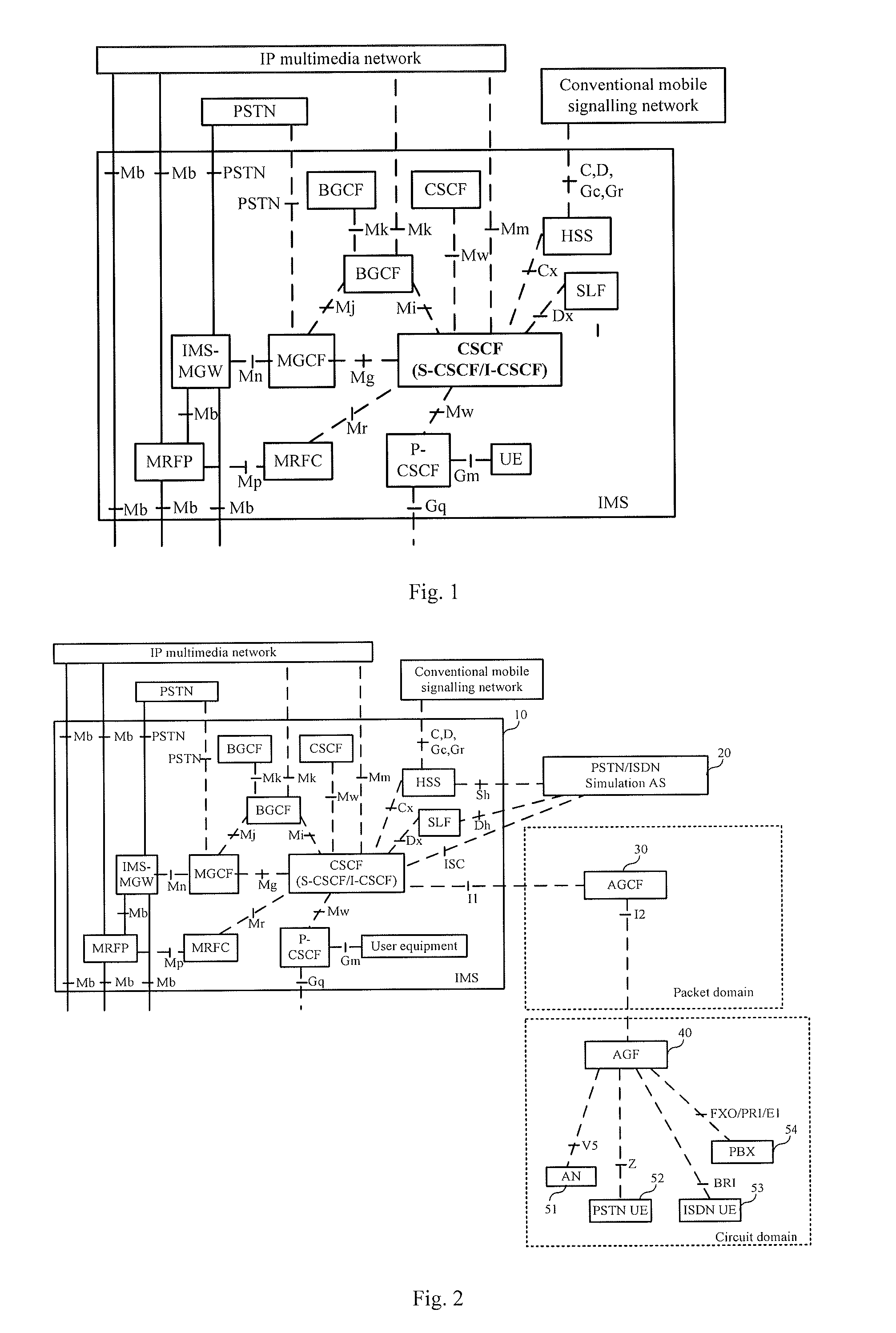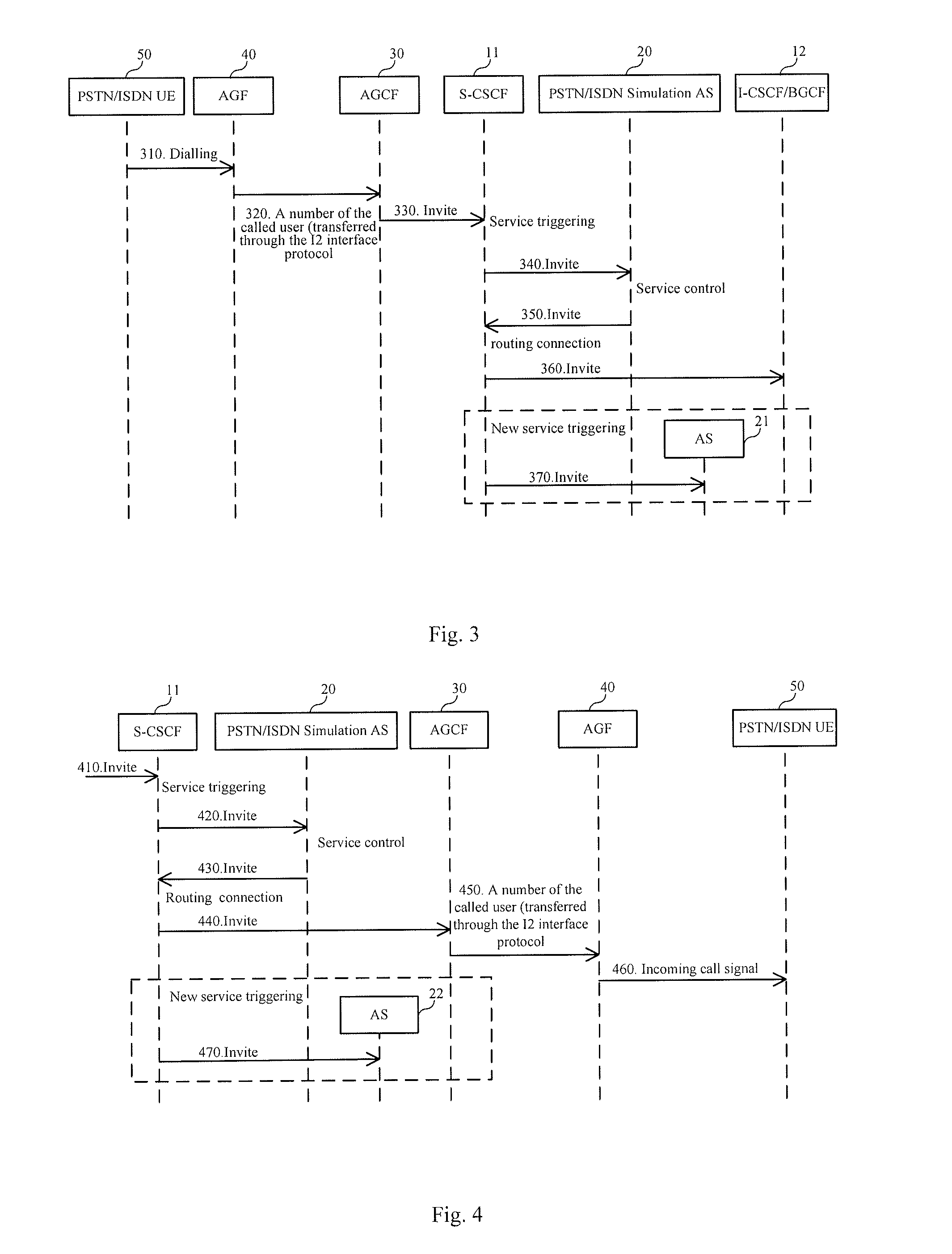[0153] Besides the advantages above, such as achieving seamless integration of the fixed network with the mobile network in terms of the IMS, because the improvement on the basis of the IMS, the technical solutions also have the following characteristics.
[0066] Through adopting the technical solutions, the terminal which is not supported by the IMS previously, such as a PSTN / ISDN terminal, can access the IMS, and the resources of the IMS may be used fully to provide the terminals with the services. Thus, the extended IMS becomes a general telecommunication service network allowing the access of various terminals.
[0149] As can be seen from the embodiments above, new application services may be customized quickly for PSTN / ISDN users. The PSTN / ISDN services, as a
network service ability of the IMS, can participate in fast combination of services or customization of new application services. All the services in the IMS are combination of multiple ASs, and each AS provides a basic
network service ability or a specific value-added service, and all the ASs can perform combination of new application services by a service subscription rule as
network sharing components; all the ASs can also be open through a
third party application interface, by which new application services may be customized by a
third party.
[0073] In an embodiment of the present invention, a new network node, that is, an AGCF, is introduced to the IMS defined in the 3GPP R5 / R6 standard. Through managing an access device, a PSTN user and an ISDN user are able to access an IMS domain, and PSTN / ISDN services are provided to the PSTN user and the ISDN user. Furthermore, functions of each network node in the IMS defined in the 3GPP standard remain unchanged, and an accessing user may be regarded as a user in the IMS domain, such as a 3G mobile user because the AGCF shields differences between accessing users. The PSTN / ISDN services may be implemented by the AGCF, or be managed by a PSTN / ISDN
Simulation Application Server (AS), i.e. a first
application server, in the IMS in a centralized manner; or a
basic service and a supplementary service are managed by the AGCF while an extended value-added service is managed by the PSTN / ISDN
Simulation AS.
[0073] In an embodiment of the present invention, a new network node, that is, an AGCF, is introduced to the IMS defined in the 3GPP R5 / R6 standard. Through managing an access device, a PSTN user and an ISDN user are able to access an IMS domain, and PSTN / ISDN services are provided to the PSTN user and the ISDN user. Furthermore, functions of each network node in the IMS defined in the 3GPP standard remain unchanged, and an accessing user may be regarded as a user in the IMS domain, such as a 3G mobile user because the AGCF shields differences between accessing users. The PSTN / ISDN services may be implemented by the AGCF, or be managed by a PSTN / ISDN
Simulation Application Server (AS), i.e. a first
application server, in the IMS in a centralized manner; or a
basic service and a supplementary service are managed by the AGCF while an extended value-added service is managed by the PSTN / ISDN Simulation AS.
[0153] Besides the advantages above, such as achieving seamless integration of the fixed network with the mobile network in terms of the IMS, because the improvement on the basis of the IMS, the technical solutions also have the following characteristics.
[0073] In an embodiment of the present invention, a new network node, that is, an AGCF, is introduced to the IMS defined in the 3GPP R5 / R6 standard. Through managing an access device, a PSTN user and an ISDN user are able to access an IMS domain, and PSTN / ISDN services are provided to the PSTN user and the ISDN user. Furthermore, functions of each network node in the IMS defined in the 3GPP standard remain unchanged, and an accessing user may be regarded as a user in the IMS domain, such as a 3G mobile user because the AGCF shields differences between accessing users. The PSTN / ISDN services may be implemented by the AGCF, or be managed by a PSTN / ISDN Simulation
Application Server (AS), i.e. a first
application server, in the IMS in a centralized manner; or a
basic service and a supplementary service are managed by the AGCF while an extended value-added service is managed by the PSTN / ISDN Simulation AS.
[0155] Conflicts between multiple services are effectively avoided, and problems, such as multiple triggering of a service, providing a service by multiple points, nesting dialling of a service, are resolved. All the services in the IMS are triggered by the S-CSCF through the user service subscription data, and conflicts between triggering of the PSTN / ISDN services and triggering of other services, such as the intelligent service, may be effectively avoided by setting an appropriate trigger rule. The PSTN / ISDN services are uniformly implemented by one network node, that is, the AS, and the AS can coordinate various PSTN / ISDN services properly and arbitrate when the conflicts between services occur.
[0070]FIG. 4 shows a
schematic flowchart of an incoming call to a user accessing through an AGF in the method for processing a packet domain service
signal in accordance with an embodiment of the present invention.
[0158] The
wide area service is implemented easily, and plenty of cross-domain IP
Centrex services may attract more enterprise clients. Because all the user data of the PSTN / ISDN services are collected and managed in HSSs in the IMS and the location between the multiple HSSs may be determined using the SLF in the IMS, thus the
wide area service may be implemented easily.
[0159] The
enterprise services and group services may be customized quickly and conveniently. In the IMS, the PSTN / ISDN Simulation AS may exist as multiple physical entities, and a separate AS of the
enterprise services and group services may be customized for the users with a special demand. Thereby, customized services with individualized characteristics may be provided quickly and conveniently without
impact on other services and users.
 Login to View More
Login to View More  Login to View More
Login to View More 


